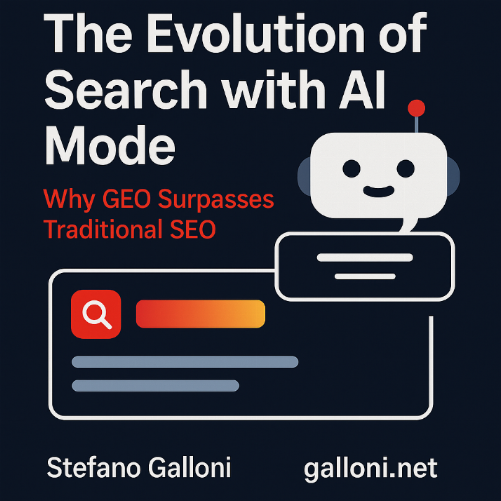Article
Author: Stefano Galloni
Website: galloni.net
Introduction
In recent years, search on Google has evolved beyond simple ranked links: with the introduction of AI Mode, Google is integrating generative models like Gemini to directly answer complex queries. In parallel, the discipline of GEO (Generative Engine Optimization) has emerged, aiming not just to rank content, but to have your content cited or synthesized directly by generative models.
In this article we will explore:
-
What AI Mode is and how it works
-
Differences between traditional SEO and GEO
-
How to draft “GEO‑ready” content
-
Practical strategies to be cited in generative responses
-
Risks, challenges, and a roadmap for the future
1. What is AI Mode and How It Changes Search
In 2025, Google introduced AI Mode: a generative extension of search that combines the classic index with the power of LLMs (e.g. Gemini). Google describes AI Mode as its most powerful mode, capable of decomposing complex queries into sub‑questions, aggregating results from multiple sources, and synthesizing answers.
1.1 Internal Mechanism: Query Fan‑Out and Aggregation
AI Mode “fans out” a complex query into sub-queries, executes them in parallel, and aggregates the best results through the generative model. This allows deeper insight than traditional snippets. Research shows that many AI Mode responses include a sidebar or answer box with ~7 distinct domains, often overlapping with top organic results.
1.2 Impact on Clicks & Citations
In AI Mode, ranking first is no longer the sole objective: getting cited as a source in the AI-generated answer is equally valuable. The generative model may incorporate your content (or excerpts) directly in its reply, which changes how visibility works.
2. From SEO to GEO: Core Differences
2.1 Primary Objective
-
Traditional SEO: Rank higher in SERP, increase CTR, drive traffic
-
GEO: Be cited or referenced within generative model responses
2.2 Success Metrics
-
SEO: impressions, rankings, CTR, backlinks
-
GEO: number of generative model citations, inclusion in synthesized answers
2.3 Content Typology
GEO‑optimized content is tailored for LLMs: isolated paragraphs, clear entity definitions, structured data, FAQs, tables, and succinct summaries.
2.4 Freshness & Authority
Generative models favor newer, authoritative content. Updating “pillar” pages regularly increases chances of being cited in AI-generated summaries.
3. Principles for GEO‑Ready Content
3.1 Clear, Fragmented Structure
Use H2/H3 headings, bullet lists, short paragraphs—making it easier for a model to extract a piece of content.
3.2 Explicit Entities & Definitions
Include named entities, dates, definitions, and relationships to help the model semantically link your content with external sources.
3.3 Data & Proof
Stats, case studies, and documented evidence strengthen the trust of the model and increase citation likelihood.
3.4 Well-Formed FAQs
Short Q/A pairs are often directly used by models in their responses.
3.5 Schema / Structured Markup
While not guaranteed, using structured data (Schema.org) helps models interpret your content semantically.
3.6 Regular Updates
Revisit and enrich pages with new insights, aligning to evolving queries and trends.
4. Application Example: Being Cited for “AI Mode Differences”
Assume someone asks: “How does Google’s AI Mode differ from traditional SEO?”
You can craft:
“Google’s AI Mode differs from traditional SEO through a query fan-out mechanism, dividing complex searches into sub-queries and aggregating results via generative models.”
You might also include a FAQ:
Q: What is the query fan-out method?
A: It’s a technique by which Google splits a complex query into sub-questions, executes them separately, and lets the LLM synthesize a cohesive answer.
A model may directly quote this paragraph and cite it.
5. Challenges, Risks & Limitations
5.1 Brand Bias
Large, known brands may be favored by models. For niche sites, it’s harder to break through—requiring stronger strategy.
5.2 Model Evolutions
LLMs update. What works today may not tomorrow.
5.3 Scale & Maintenance
Optimizing GEO at scale calls for templates and processes, not manual one-off pages.
5.4 Attribution & Tracking
It’s hard to track traffic from generative responses. Tools like UTM, brand monitoring, and SERP scraping are necessary.
6. Suggested Roadmap
-
Audit hotspots: Identify pages with potential (pillar guides, definitions)
-
Restructure for GEO: Add FAQs, entities, extractable paragraphs
-
Generate new GEO-oriented content on AI/LLM/search topics
-
Obtain external mentions: guest posts, authoritative citations
-
Monitor model citations: use SERP tools or AI tracking
-
Regularly refresh content with newer data, queries, and trends
